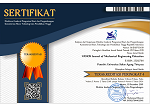THE EFFECT OF ROLLING CYCLES AND SETTING DIRECTION OF THE REINFORCEMENT ON ALUMINUM BASED COMPOSITE BY REPETITIVE PRESS ROLL FORMING (RPRF) METHODS
Abstract
Development of technology shown rapid progress in various of structural applications especially on advanced of component in industry. Using of aluminum as a matrix on composite fabrication by addition ceramic as reinforcement is the better solution, for expected to improve the mechanical properties on materials-based composites. The process carried out was combining SiC particles with an aluminum (AA1100) as a matrix with variations number of rolling cycle’s: 2, 4 and 6 as direction. Preparation of SiC particles with transverse, cross section and mix variations through a hot working process with the technology of severe plastic deformation (SPD) using the method of repetitive press roll forming (RPRF). The results obtained was mechanical properties increased when the roll cycles high with mix of variations in the direction of SiC arrangement resulting in a wider distribution of SiC into the matrix AA1100. Rolled process by cycle 6 and the direction of the SiC mix resulted in higher hardness of 55.54 HV, tensile strength was 90.46 MPa, porosity 0.33% density 1.831 gr/cm3 and SiC distribution 23.19%. Increasing the number of rolling cycles, the thickness of the interface for the formed layer and the size of SiC particles will decrease due to SiC particles scattered in most aluminum matrices, which can increase the hardness value.
Keywords
Full Text:
PDFReferences
Agus Pramono, Anistasia Milandia, Kurnia Nugraha and Moch Fawaid. Alluminum alloys by ECAP Consolidation for Industrial Application. VANOS Journal of Mechanical Engineering Education. Vol 2. 2 . 117-125 (2017).
Agus Pramono, Merging method of aluminum fiber composite materials with alternating pressure and rolling process using Repetitive Press Roll Forming technology. Application number: 001/P/HKI/2000. University of Sultan Ageng Tirtayasa Banten. Patent, P00201709889 (2017).
Agus Pramono, Alry Mochtar Jamil and Anistasia Milandia (2018). Aluminum based Composites by Severe Plastic Deformation Process as New Methods of Manufacturing Technology. MATEC Web of Conferences. Vol. 218, 04011. Pp. 1-9.
Palanikumar, K, R, Karthikeyan. 2007 ‘Assesmen of Factor Influencing Surface Rougness on the machining of Al/SiC Particulate Composites’, Material and Design 28. Vol. 8, No. 6, hh. 455-467.
Singla, Manoj, D, Deepak Dwivedi, Lakhvir Singh, & Vikas Chawla. 2009, 'Development of Aluminium Based Silicon Carbide Particulate Metal Matrixs Composites’. Journal of Material & Material Characteritation & Engineering. Vol. 8, No. 6, hh. 455-467.
Luthfi, Syukron. 2010, ‘Effect of Magnesium on Electroless Coating Process on SiC Strengthening Particles. Department of Metallurgy and Materials Engineering, University of Indonesia.
Hashim, J, L, Looney, & M.S.J Hashmi. 2002, ‘Particle distribution in cast metal matrixs composites-Part I’. Journal of Materials Precessing Tecgnology 123, pp. 251-257
J. Zrnik and S. Vdobatkin. 2008, ‘Processing Of Metals By Severe Plastic Deformation (SPD) - Structure And Mechanical Properties Respond’, vol.47, no. 3, hh. 211-216,
Srinivasa, R, Bakshi, Arvind, A., 2011 "An Analysis Of The Factors Affecting Strengthening In Carbon Nanotube Reinforced Aluminum Composites", Jordan Journal of Mechanical and Industrial Engineering, 533-541.
Pramono, Agus, Kollo, Laury, & Veinthal Renno. 2016, ‘Hot and cold region during accumulative roll bonding of Al/Al2O3 nanofibre composites". Proceeding of the Estonisn Academy of Science. 65. 2. hh.132-137 .
Pramono, Agus., Kollo, Laury, & Veinthal, Renno. 2015, ‘Aluminum based composite by Novelty Process : Repetitive Press Roll Bonding. International Symposium on Applied Chemistry. 16 (2)
Zheng Lv. Xueping Ren. Wenjing Wang. Xiaodan Gao. and Wenjie Li. 2016.Microstructure and Mechanical Properties of Mg/2 wt.%SiCp
Nanocomposite Fabricated by ARB Process. Journal of Nanomaterials.
Page : 12. Hindawi
Alizadeh M, Paydar M.H. 2010, ‘Fabrication Of Nanostructure Al/SiC By Accumulative Roll-Bonding (ARB) Process. Journal Of Alloys And Compounds (492). Elsivier
S.O. Gashti. A. Fattah-alhosseini. Y. Mazaheri. M.K. Keshavarz. 2015. Effects of Grain Size and Dislocation Density On Strain Hardening Behavior Of Ultrafine Grained AA1050 Processed by Accumulative Roll Bonding. Journal of Alloys and Compounds. Page: 854-861. Elsevier
DOI: http://dx.doi.org/10.30870/vanos.v3i2.4348
Refbacks
- There are currently no refbacks.

This work is licensed under a Creative Commons Attribution 4.0 International License.


.png)
.png)
